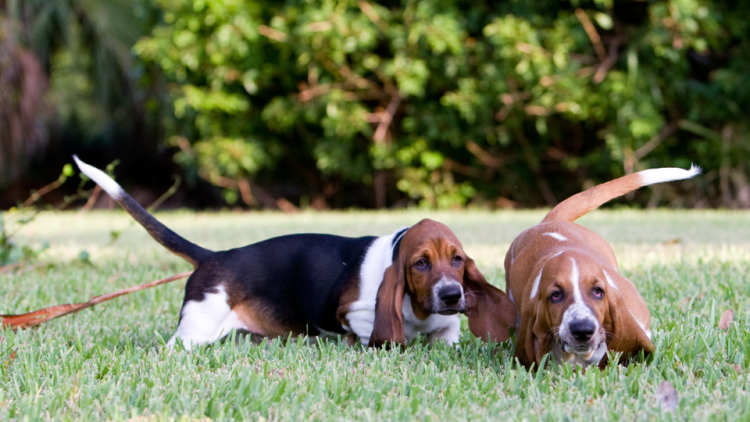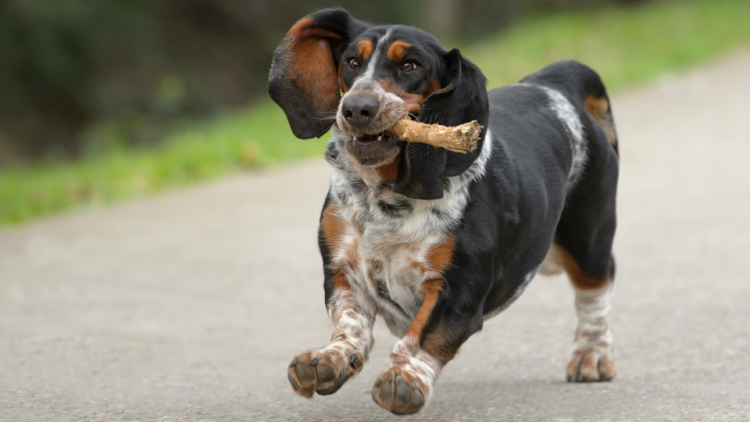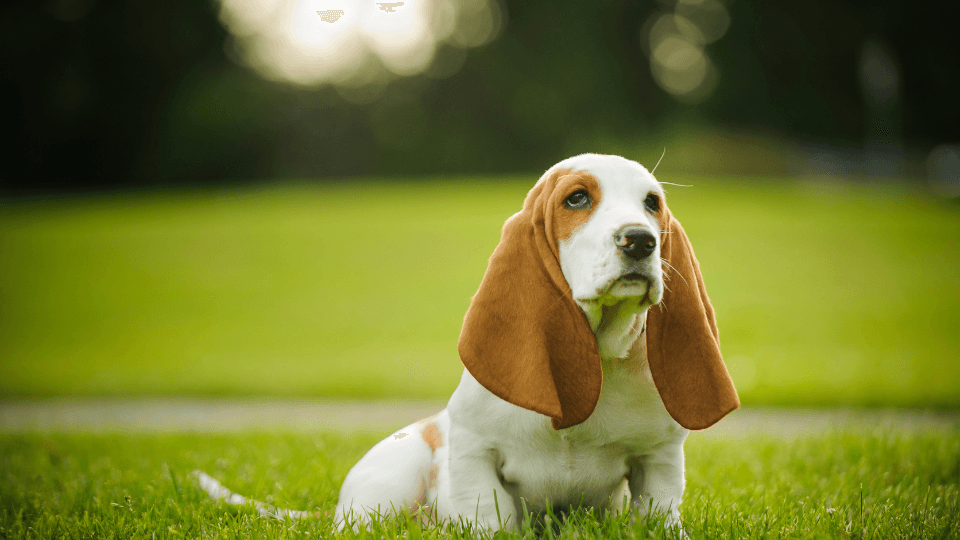Famous for their long, velvety ears, solemn expression, and short legs, the Basset Hound breed captivates the hearts of many with their charming, endearing personality and head-turning looks. Basset Hounds were initially bred for scent tracking over rough terrain. Their incredible sense of smell - second only to the Bloodhound - made them a favorite among French aristocrats for chasing deer and rabbits on the hunt. At home, Basset Hounds are patient, agreeable, and low-key dogs that make great companions.
So as a famously short dog breed designed to track scents, just how big do Basset Hounds get? If you’re the lucky pet parent to one of these loyal hounds, you can use our Basset Hound growth chart to track your pup’s growth and development.
Here’s everything you need to know about Basset Hound weight, size, and growth rate:
- Basset Hound Weight Chart
- At what age is a Basset Hound fully grown?
- How big should a 6-month-old Basset Hound be?
- How much bigger will my Basset Hound get?
- What is the size of a full-grown Basset Hound?
- How do I make sure my Basset Hound is healthy?
- Key Takeaways
Pro Tip: Pet owners can be reimbursed for up to 90% of veterinary bills by enrolling in a pet insurance plan. Compare options for Basset Hound health insurance to get peace of mind knowing your puppy has access to gold-standard veterinary care for life.
Basset Hound Weight Chart
| Age | Weight |
|---|---|
| 1 month old | 3 - 5 lb |
| 2 months old | 10 - 15 lb |
| 3 months old | 15 - 25 lb |
| 4 months old | 20 - 30 lb |
| 5 months old | 25 - 35 lb |
| 6 months old | 30 - 40 lb |
| 7 months old | 30 - 45 lb |
| 8 months old | 35 - 45 lb |
| 9 months old | 35 - 50 lb |
| 10 months old | 40 - 55 lb |
| 11 months old | 40 - 55 lb |
| 12 months old | 40 - 60 lb |
| 2 years old | 40 - 65 lb |
They may appear smaller due to their short stature, but Basset Hounds are surprisingly heavy dogs that need more time to finish filling out than many other medium-sized dogs. The Basset Hound growth rate should be slow and steady, as the breed is commonly known for putting on an unhealthy amount of weight.
If your pup is slightly above or below the numbers in the Basset Hound weight chart, don’t worry just yet. These figures are estimates by age, but all puppies grow at their own rate. Consult with your veterinarian about concerns you may have over your pup’s growth pattern and come up with a weight management program that will maintain their long-term health for a long, happy life.
At what age is a Basset Hound fully grown?
Like all dogs, Basset Hounds are considered adults at a year old. However, they typically need at least 16 months to reach their full size. Larger Basset Hounds may require a full two years to fill out their chest completely.
How big should a 6-month-old Basset Hound be?
A 6-month-old Basset Hound will weigh between 30 to 40 pounds on average. Male Basset Hounds are typically slightly heavier than their female counterparts and will likely fall on the higher end of this range.
As for height, most puppies will be around 75% of their adult height at six months old. For Basset Hounds, this puts them around 9 to 11 inches at 6 months old, as most Basset Hounds will be up to 15 inches tall as adults.
Pro Tip: Download and print this new puppy checklist for essential tips on puppy-proofing your home, creating a vaccine schedule, saving money at the vet, and more.

How much bigger will my Basset Hound get?
There are a few ways to estimate how much bigger your Basset Hound puppy will get.
- Age. Your puppy’s age is the biggest indicator of how much bigger they may grow. If your Basset Hound is less than 16 months old, they are probably still filling out. Many Basset Hounds, especially males, will even need up to two years to finish filling out their chest. If your pup is less than a year old, you can expect them to have significant growing left to do.
- Paw Size. Your Basset Hound’s paws are another indicator of how much growing they may still have left to do. If their paws look oversized next to their body and legs, this is a classic puppy feature indicating that they still have growing left to do.
- Genetics. Lastly, if you purchased your Basset Hound puppy from a breeder, contact them about your puppy’s estimated adult size. Your breeder can give you a more precise estimate based on your pup’s parents and previous litter sizes. A puppy rarely grows to be bigger than its larger parent, so this gives you an idea of their maximum weight and height too.
What is the size of a full-grown Basset Hound?
An adult Basset Hound weighs between 40 and 65 pounds, according to the American Kennel Club Official Basset Hound Breed Standards. Most of the time, the weight of a Basset Hounds male falls on the heavier side of this range. Both male and female Basset Hounds should stand no taller than 15 inches when measured at the shoulders.
It’s vital that you monitor a Basset Hound’s weight closely. These dogs are very prone to putting on additional weight throughout their life and are frequently obese. As loving pet parents to Basset pups, it’s crucial for owners to pay close attention to the dog’s calorie intake and provide plenty of exercise to promote a healthy weight.

How do I make sure my Basset Hound is healthy?
As purebred dogs, Basset Hounds are more prone to a variety of genetically inheritable diseases. While this is hard to hear as a loving pet parent, preventative care can cure or minimize many health problems your Basset Hound may be prone to. Remember that prevention is always better than treatment. Preventive care, such as dog dental cleanings and annual veterinary exams, gives your veterinarian the chance to screen and catch diseases early on.
Basset Hounds are particularly susceptible to panosteitis, hip dysplasia, skin diseases, and various eye conditions, like abnormal eyelids, glaucoma, and lower eyelid droop. Due to their large ears, they are also at a heightened risk of ear infections.
According to the Veterinary Centers of America, panosteitis is a painful condition that occurs when the outer shaft of the leg bones becomes inflamed. Unfortunately, Basset Hounds are among the dog breeds most affected by panosteitis. There is no treatment for panosteitis, but it typically goes away by the time a dog finishes growing. However, during its effect, the disease often leaves the young dog in extreme pain and, sometimes, temporarily lame.
Pain medication and anti-inflammatory drugs are crucial to ease discomfort and help your dog feel better as they grow and the disease is present. Medication and veterinary visits can quickly add up during a long-term illness, like panosteitis. Even the cost of treatments for recurring ear and eye conditions can quickly become a financial burden. Other diseases, like hip dysplasia, typically require surgery to treat, which can rapidly become expensive.
Basset Hound Veterinary Costs
Pet insurance can provide a safety net for you and your Basset Hound puppy throughout the course of their life. Once you’ve met your deductible, the insurance provider reimburses you for a portion of the out-of-pocket cost per vet visit. It’s important to enroll in Basset Hound insurance while your pup is still young and in great health, so veterinary treatments for illnesses that may arise later on can be covered under the policy.
If you prefer, you can select accident-only pet insurance and have peace of mind knowing your loved one has affordable access to essential care in case of an emergency medical condition. Or, extend your coverage with a pet wellness plan that includes the cost of spay- or neutering, vaccinations, flea/tick prevention, and more.
Key Takeaways
- Our Basset Hound growth chart predicts the weight of your Basset Hound puppy until they stop growing around 16 months old.
- Official American Kennel Club standards state that Basset Hounds should weigh between 40 and 65 pounds as adults.
- As a breed, Basset Hounds are prone to a variety of hereditary conditions.
- Prevention is always better than treatment. Preventative care is the best way to ensure that your Basset Hound pup lives a happy, healthy life, so you may want to enroll in a pet insurance plan to save money on eligible costs.
